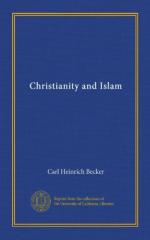Upon similar principles we may explain the demand for the utmost simplicity and reserve in regard to the other enjoyments of life. To eat whenever one may wish is excess and two meals a day are more than enough. The portion set apart for one may also suffice for two. Ideas of this kind are of constant recurrence in the Muhammedan traditions: indispensable needs alone are to be satisfied, as indeed Thomas Aquinas teaches. Similar observations apply to dress: “he who walks in costly garments to be seen of men is not seen of the Lord.” Gold and silver ornaments, and garments of purple and silk are forbidden by both religions. Princes live as simply as beggars and possess only one garment, so that they are unable to appear in public when it is being washed: they live upon a handful of dates and are careful to save paper and artificial light. Such incidents are common in the oldest records of the first Caliphs. These princes did not, of course, live in such beggary, and the fact is correspondingly important that after the lapse of one or two generations the Muhammedan historians should describe their heroes as possessing only the typical garment of the Christian saint. This one fact speaks volumes.
Every action was performed in God or with reference to God—an oft-repeated idea in either religion. There is a continual hatred of the world and a continual fear that it may imperil a man’s soul. Hence the sense of vast responsibility felt by the officials, a sense which finds expression even in the ordinary official correspondence of the authorities which papyri have preserved for us. The phraseology is often stereotyped, but as such, expresses a special theory of life. This responsibility is represented as weighing with especial severity upon a pious Caliph. Upon election to the throne he accepts office with great reluctance protesting his unworthiness with tears. The West can relate similar stories of Gregory the Great and of Justinian.




